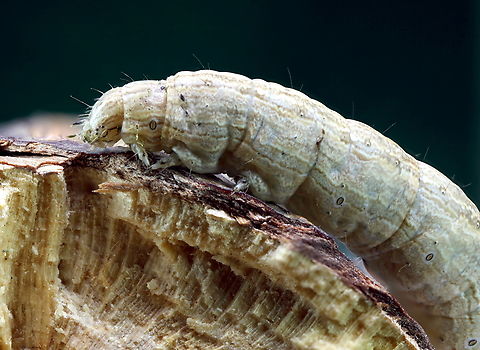
Behavior
In one year, the variegated cutworm will have two to four generations. Generally, in colder areas, such as the Canadian populations of "P. saucia", the moth undergoes two generations, whereas in warmer regions, "P. saucia" has three to four generations per year. Additionally, while pupa and larvae may be able to live through the winter, moths still migrate into cooler areas each spring and return to the warmer areas each fall. The moths travel long distances when migrating each year, so researchers have found it difficult to determine the exact number of generations based on just the adult populations of moths.Reproduction
The larval stage of "P. saucia" has 6 instars. The developmental threshold for these larvae is 2.6–6.7 °C. The first instar has an average duration of 6.5 days, a head capsule width of 0.30–0.35 millimeters, and a body length of 2.0–3.0 millimeters; the second instar has an average duration of 4.6 days, a head capsule width of 0.46–0.62 millimeters, and a body length of 3.6–6.5 millimeters; the third instar has an average duration of 4.8 days, a head capsule width of 0.80–1.00 millimeters, and a body length of 5.3–9.0 millimeters; the fourth instar has an average duration of 4.7 days, a head capsule width of 1.20–1.65 millimeters, and a body length of 12–16 millimeters; the fifth instar has an average duration of 6.7 days, a head capsule width of 1.9–2.6 millimeters, and a body length of 25–28 millimeters; the sixth instar has an average duration of 16.8 days, a head capsule width of 3.0–3.2 millimeters, and a body length of 35–46 millimeters. The larvae are generally colored brownish-gray to grayish-black, with a distinctive yellow or white spot on the dorsal side of their first four to six abdominal segments. Additionally, "P. saucia" larvae have a black W-shaped mark on the 8th abdominal segment of their sixth instar and a black line laterally above their spiracles. The head of the larvae is generally orange-brown with darker spots.Food
The variegated cutworm feeds mainly when the sun sets. The larvae often hide in the soil or under other shelter during the daytime and move to foliage in the evenings to feed. "P. saucia" is known to invade greenhouses, where food is plentiful. Larvae are also known to consume large amounts of plants during development, with studies showing up to 125 square centimeters of sugarbeet or 160 square centimeters of potato foliage eaten during their larval stage.Predators
The variegated cutworm has a number of predators. Wasp and fly parasitoids account for most of the larval deaths each year. Braconidae, Ichneumonidae, Eulophidae, Tachinidae species have been observed as attacking "P. saucia" larvae. Some of the most common organisms that attack the larvae include: "Apanteles xylinus", "Chelonus insularis", "Chelonus militaris", "Meteorus autographae", "Meteorus leviventris", "Microplitis feltiae", "Rogas perplexus", "Rogas rufocoxalis", "Campoletis sonorensis", "Enicospilus merdarius", "Nepiera fuscifemora", "Ophion flavidus", "Dibrachys canus", "Archytas aterrimus", "Archytas cirphis", "Bonnetia comta", "Carcelia" spp., "Chaetogaedia monticola", "Clausicela opaca", "Eucelatoria armigera", "Euphorocera claripennis", "Euphorocera omissa", "Gonia longipulvilli", "Gonia porca", "Gonia sequax", "Lespesia archippivora", "Madremyia saundersii", "Peleteria texensis", "Periscepsia helymus", "Periscepsia laevigata", "Voria ruralis", "Winthemia leucanae", "Winthemia quadripustulata", "Winthemia rufopicta". It is also likely that many other species of wasps and flies attack "P. saucia".References:
Some text fragments are auto parsed from Wikipedia.